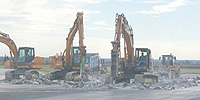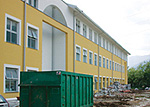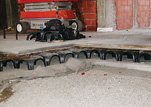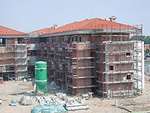 |
Five years after the U.S. Air Force moved its 31st Fighter Wing to Italy's Aviano Air Base, the Pentagon's largest military construction project was slogging almost to a halt. Bureaucratic contracting complexities, cultural differences between local Italian contractors and an overburdened base engineering staff were compounded by the Air Force's growing military role in a series of conflicts in Bosnia and Serbia. In 1998, when senior combat officers began to be drawn too far into construction management, top Air Force officers stepped in to establish a separate program management office that now has the $530-million project headed for a 2007 completion.
 |
|
A SUCCESS Aviano's 7,500-ft-long runway was repaved in a 32 day project. (Photo courtesy of the Air Force) |
"Five years into the project is probably a little too late," deadpans Air Force Col. Gary C. LaGassey, program manager for the Aviano 2000 program, about the establishment of his office. Still, observers credit the career Air Force officer with no previous construction or program management experience, with turning the job around through some commonsense management practices and the buildup of the office from six overworked project engineers to more than 25 staffers, including experienced program and project managers brought in from various service branches and the private sector.
Their job, born out of international politics, is largely a mix of quality-of-life and infrastructure improvement projects funded by the U.S., Italy and the North Atlantic Treaty Organization. Unlike most centralized military bases, Aviano Air Base is split into seven areas scattered across the sleepy town from which it draws its name. Tucked beneath the Dolomite Alps about 90 kilometers north of Venice, the air base has been a military backwater since World War II. During the Cold War, NATO invested heavily in bases closer to central Europe where the threat from the Soviet Union and Warsaw Pact was deemed heaviest. Aviano maintained its second-class status, designed only to receive reinforcing squadrons in the event of a major East-West conflict.
 |
| SCENIC Dolomites are backdrop for $530-million project to upgrade airbase. (Photo by John J. Kosowatz for ENR) |
That changed in the early 1990s, when Spain demanded the U.S. abandon its air base there. NATO still wanted a U.S air presence in southern Europe and agreed to fund $350 million in improvements to Aviano, woefully undersized and outmoded for a high-tech, combat-ready wing of 42 F-16 fighters, 3,500 airmen and women and dependents that swelled the overall population to some 9,000 people. The 31st's arrival in 1994 more than doubled the base population, setting in motion a buildout that NATO had never seen before, and one that was sputtering by 1997.
Historically, NATO funds only military support and operations projects. For Aviano, it broke that practice as part of the deal to keep the Air Force in the region. "It's the first time NATO is paying for quality-of-life projects," says Nancy Balkus, project management branch chief for the PMO.
 |
| FRACTURED Base areas are scattered and split by local roads. (Photo by John J. Kosowatz for ENR) |
The first contracts for 60 small and medium-sized projects needed for fighter beddown and and basic personnel needs were funded through $62 million in U.S. Dept. of Defense emergency funds. Those jobs, most managed by the base civil engineer, were completed by 1999. But more serious scheduling problems developed between 1995-1997 as the 85 NATO-funded projects began to wind their way through initial design and contract approval. NATO lacked standards for buildings such as hospitals, dormitories, childcare facilities and some utilities. As the program progressed, NATO's contract review operation in Brussels fell behind as the number of contracts increased and the number of reviewers fell. Eventually, only one screener was available to approve documents.
The process further jammed because design and construction contracts had to be advertised, most of them separately, through the embassies of 19 member NATO countries. And base engineers needed to tend to their primary duties of supporting the fighter wing, which increased the number of daily sorties flown from about 40 to over 200 as the Kosovo campaign climaxed in the late 1990s.
 
|
|
PROBLEM School (left) fell behind schedule when contractor defaulted. Baffales beneath slab collect randon gas. (Photos by John J. Kosowatz for ENR) |
"It was a runaway program," he says. "There were no change controls, deadlines were missed, there were not enough people and there was no communication. I didn't know crap about project management. I read every program management text I could find."
 |
Navigating among Aviano's many sponsors and contracting agents would frustrate an experienced program manager. Although the upgrade is a NATO project, Italy is the host country and owns the base. All contracts must comply with Italian legal standards. Another 174 projects worth some $180 million are funded through multiple Air Force accounts and are managed by the base civil engineer, who can bring in the Army Corps of Engineers as a contracting agent. Congressionally funded military construction projects over $500,000 are managed by the U.S. Navy, the Pentagon's design and construction agent in the Mediterranean. The Naval Facilities Engineering Command's Engineering Field Activity Mediterranean in Naples also manages 32 U.S.-executed squadron support contracts authorized through a negotiated agreement with Italy. As host, Italy is charged with executing all contracts and is managing another 25 through its Defense Engineering Activity.
 |
|
ITALIAN STYLE Seabees' Sanders (above left) oversees housing work. (Photo by John J. Kosowatz for ENR) |
Taken individually, few of the program's 264 contracts pose extraordinary design or construction challenges. The largest is a $33-million K-12 school. The most high-profile was a $6.1-million runway rehabilitation in 1999. That fast-track job forced the wing to redeploy for 32 days while a Perini-Jones joint venture stripped and repaved the 7,500-ft-long runway with a stone-matrix asphalt that should protect better against rutting, says construction project engineer Bill Crone.
Taken as a whole, however, the great number of projects and lack of a central management and scheduling office became a nightmare.
The lineup of projects seems never-ending. Some flightline projects include construction of aircraft arresting systems, airfield lighting, a control tower, radar approach control and squadron operations systems. Support projects include buildings for jet engine and avionics systems, ground fuel and hot-pit refueling stations, warehouses, munitions storage and others. And scattered throughout the base and town are quality-of-life projects such as a 20-bed hospital, dormitories and family housing, dining facilities, a base exchange and commissary.
 |
One of LaGassey's first moves was to bring in Virginia Beach, Va.-based Doran Consulting Inc. to review the program and establish a project management information system. Using Microsoft Project for program scheduling, Doran became a linchpin in the fledgling management system. As the PMO became established, an intranet system was developed to disseminate project information.
Some of that includes maps produced through GIS systems to determine, among other items, contingency safety arcs within the flight zone where contractors are protected from flight operations and munitions, and a bypass for through-traffic traveling the road that bisects the base. The digitalized documents have an accuracy to within 10 centimeters, says planner Ron DiBenedetto. The airfield obstruction management system was produced through a contract with CH2M Hill Cos. Earlier contracts with URS and Law Environmental Services produced an implementation plan and asbestos-removal strategy.
Web-based requests for information could come soon, hopes Cdr. Dave Kelley, NAVFAC's chief program officer. Kelley rides herd on 40 projects worth $250 million. His program is peaking in FY2002 at $53 million. Seventeen projects costing $70 million are already complete and another 17 worth $140 million are in planning or construction, with seven others still to come. "Right now the Navy is putting $1 million into the ground every week," he says.
 |
|
DIVISION OF LABOR Hanger rehabilitation is part of support program overseen by Christiani (above left). (Photos by John J. Kosowatz for ENR) |
Design for construction in seismic zone three is based on the more stringent of either U.S. or Italian standards. There are some exceptions, but NATO bid requirements force the PMO to accept firm, fixed-price lowest bids, contrary to NAVFAC's preference for best value source selection. That and confusion from local contractors over bid requirements have led to some delays and, in some cases, a change in contractors.
"We found that there were differences in what the Italian contractors bid and what we wanted to do," says Kelley. "For instance, we don't accept the standards for Italian elevators. We want a full-time engineer on site and we do not accept standard Italian windows."
Hoping to stanch the flow of frequently missed bid items, Kelley began calling pre-bid meetings two years ago. The turnout was tremendous. "About 25% of the contractors were at our door," he says.
Those meetings, constructibility reviews and regular reviews with the project management office have contributed to greater speed and efficiencies in contractor performance. Kelley's stable of contractors has also leveled off at about five firms, down from 10 to 15 earlier in the program.
Change order rates are now averaging less than 4%, he says. The project has seen an average cost growth of 4%, largely tied to utilities. A fire destroyed most as-built utility drawings, forcing the Navy to require contractors to use georadar systems to map lines before digging. "We were hitting stuff all of the time," says Kelley.
The biggest delays have affected the school, where the original contractor defaulted on its $21-million contract in August 2000. Udine-based Rizzani De Eccher picked up the 250,000-sq-ft project and is wrapping up before the school year begins in September.
Base housing is probably unlike any seen elsewhere in the military. New dormitories and visitors quarters are being built on land adjacent to the airfield that was formerly used for training by the Italian army. Structures in the Zappala complex must be fitted out to less than 50 decibles to protect hearing from jet takeoffs and landings. Already, a $16-million base exchange, post office and utility backbone are complete. Structures are commonly steel-framed, but Italian con- tractors prefer to work with clay block rather than concrete, notes LCDR Scot Sanders, a Navy Seabee overseeing dormitory construction. Contractors typically chisel out lines in the blocks to install conduit. All buildings include a system of baffles fitted beneath foundation slabs to capture and expel radon gas. Tiles, copper and marble are materials of choice for Italian contractors and provide style and elegance not seen on most military bases.
 |
Base housing is probably unlike any seen elsewhere in the military. New dormitories and visitors quarters are being built on land adjacent to the airfield that was formerly used for training by the Italian army. Structures in the Zappala complex must be fitted out to less than 50 decibles to protect hearing from jet takeoffs and landings. Already, a $16-million base exchange, post office and utility backbone are complete. Structures are commonly steel-framed, but Italian con- tractors prefer to work with clay block rather than concrete, notes LCDR Scot Sanders, a Navy Seabee overseeing dormitory construction. Contractors typically chisel out lines in the blocks to install conduit. All buildings include a system of baffles fitted beneath foundation slabs to capture and expel radon gas. Tiles, copper and marble are materials of choice for Italian contractors and provide style and elegance not seen on most military bases.
While Italian defense engineers technically manage NATO funds and the design process at Aviano, "the challenge is to stay on the same level [as the PMO] without the same level of resources," says Major Roberto Cristiani, the Italian Air Force's chief engineer on site. One active Italian-managed project will relocate the squadron's avionics operations from temporary trailers used since the wing was first deployed to Aviano to a permanent reinforced concrete structure.
 |
| MOVING Temporary avionics trailers (above left) will move to airside building. (Photos by John J. Kosowatz for ENR) |
Before turnover, the PMO also must furnish its 97 new structures using $40 million from the wing's budget. Keeping to schedule is even more critical because money for the "smooth move" cannot be rolled over to the next year. Base security still remains a concern, especially in town, where narrow streets separate two base areas that sprawl to the street. Eventually, LaGassey hopes to negotiate a deal with local officials to build a new road around the base and close those that intersect it.
The next major challenge will be redoing flightline utilities and incorporating fiber-optic communications wire while keeping the wing flying. Unlike the program's beginning, there's now a system to support the task.

Post a comment to this article
Report Abusive Comment